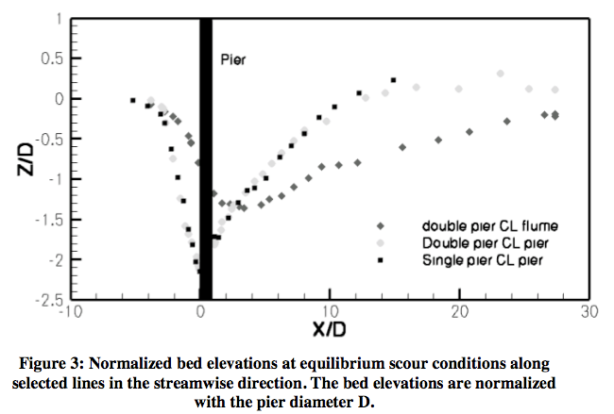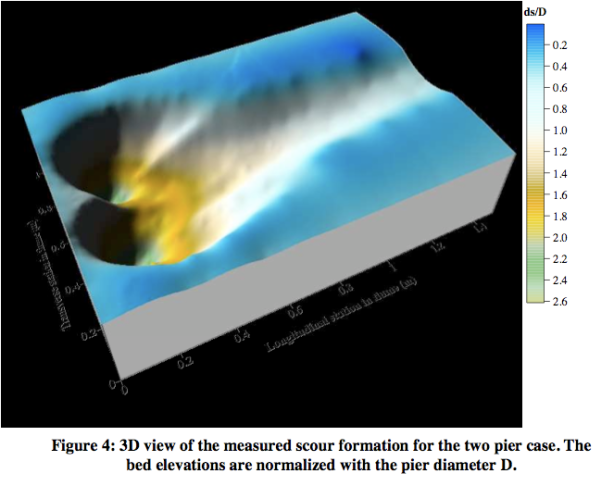Archive for the ‘Engineers’ Corner’ Category
How Under Bridge Units Work
Posted: April 29, 2009 in Engineers' Corner, InspectABridge News and PressTags: and a step by step overview, Watch a video of how under bridge access platforms work including features, www.inspectabridge.com
“Investigating scour hole formation around bridge piers” – Research at the GA Institute of Technology
Posted: April 20, 2009 in Engineers' Corner
Always interested in leading research, we asked Dr. Stoesser at The Georgia Institute of Technology to tell you about his research on the study of bridge scour. Please forward this information on to your peers, companies that do bridge scour work, and others who will benefit! See below, and enjoy! Thank you so much Dr. Stoesser!
“Investigating scour hole formation around bridge piers”
Research at the Georgia Institute of Technology
Thorsten Stoesser, Assistant Professor, School of Civil and Environmental Engineering
“Research on scour around bridge piers has been performed for decades, and during that time experimenters have attempted to provide answers to many of the complex problems associated with this phenomenon. The accurate prediction of pier scour for engineering applications is the ultimate objective of this research. Our research aims to fill this gap and provide information on how pier spacing and orientation relative to one another affects scour depths and scour hole development both upstream and down stream of the piers. A second objective of this study is to gather comprehensive data to be used for validation of sophisticated three-dimensional numerical models that are currently being developed simultaneously. These CFD models are believed to become an important design tool for practical models in the future because they are capable of accurately computing the flow and scour around piers.
Laboratory experiments were carried out to investigate how the presence of a single pier and a pair of bridge piers, respectively aligned perpendicular to the flow direction would affect the formation of the scour hole around the piers. The experiments were conducted in the Georgia Tech 1.1m wide and 24.4m long tilting flume. The piers were arranged 6.6 pier diameters (D) apart measured center to center in a flat sand-bed where the average grain size was 1.1mm. Uniform approach flow conditions were established at a flow depth of 0.16m and an average velocity of 0.33m/s. These conditions correspond to clear- water scour conditions. The experiments were run for about 5 days until equilibrium scour conditions were reached. After the flume was drained, the bathymetry around the piers was measured in detail.
The placement of a second pier in the flow causes flow contraction and acceleration and hence locally higher velocities between the two piers. This local acceleration leads to a complex three-dimensional contraction scour that interacts with the local scour around each individual pier. The scour holes around each pier of the double-pier case are almost identical in depth and shape with the scour hole around a single pier, but they are separated by a ridge and trough structure that is caused by contraction scour.
The following images and figures illustrate the research conducted at the Georgia Institute of Technology.” 



Have you seen the DOT Briefing Room from the US DOT? Stay up to date on DOT news like the following:
-
New Federal Report Highlights Improvement In Great Lakes St. Lawrence Seaway System Ballast Water Inspection Process (03/13/09)
-
U.S. Seaway Corporation Receives First Year of Infrastructure Renewal Funding (03/12/09)
-
December 2008 Airline Traffic Data: System Traffic Down 5.7 Percent in December from 2007 and Down 3.7 Percent in 2008 (03/12/09)
For some laughs, see Progressive Engineer’s page on humor. Click here for more.
“Timesheet Honesty
A promising young NASA aerospace engineer was killed in a horrific car accident and arrived in Heaven, protesting to St. Peter at the pearly gates. “St. Peter, I’m only 35. I’m much too young to die. I have a wonderful wife and family, so much to live for. Why in the world am I here?” St. Peter looked through a huge stack of papers, looked over the top of his glasses and said, “Well, according to all of these hours on your time sheets, you’ve got to be at least 108.””
The Bridge Post – Are You Signed Up?
Posted: February 19, 2009 in Engineers' Corner, News You Can UseSign Up to receive “The Bridge Post” today by emailing Robyn@InspectABridge.com! That way, you can stay up to date on current information!
The InspectABridge.com team is working to bring you the most relevant bridge information today. With news articles from trusted resources, notes from the CEO and Founder of InspectABridge.com, Pat Dandridge, and updates in the fields of Engineering and Bridge Construction, Repair and Restoration, we will provide news you can use to help save money in our current market situation.
 “Winners and Losers as Congress Approves Final Stimulus Measure” – “ENR and the Associated General Contractors estimate that the package provides more than $130 billion in construction spending. Transportation receives the largest share, more than $49 billion, with $27.5 billion of that for highways.”
“Winners and Losers as Congress Approves Final Stimulus Measure” – “ENR and the Associated General Contractors estimate that the package provides more than $130 billion in construction spending. Transportation receives the largest share, more than $49 billion, with $27.5 billion of that for highways.”
 “ASCE Assigns Grade D to Nation’s Infrastructure” – “Because decades of underfunding and inattention have endangered our nation’s infrastructure, $2.2 trillion in repairs and upgrades is needed over the next five years to meet adequate conditions. That’s the conclusion of ASCE’s new 2009 Report Card for America’s Infrastructure, which assigns an overall grade of D to the nation as well as individual grades in 15 infrastructure categories… ” Bridges earn a C. See CNN’s coverage of the story here.
“ASCE Assigns Grade D to Nation’s Infrastructure” – “Because decades of underfunding and inattention have endangered our nation’s infrastructure, $2.2 trillion in repairs and upgrades is needed over the next five years to meet adequate conditions. That’s the conclusion of ASCE’s new 2009 Report Card for America’s Infrastructure, which assigns an overall grade of D to the nation as well as individual grades in 15 infrastructure categories… ” Bridges earn a C. See CNN’s coverage of the story here.
 Are you familiar with the BridgePros website? Visit BridgePros.com to get information on bridge projects, a learning center, employment information, a products and materials center, and Much More!
Are you familiar with the BridgePros website? Visit BridgePros.com to get information on bridge projects, a learning center, employment information, a products and materials center, and Much More!


